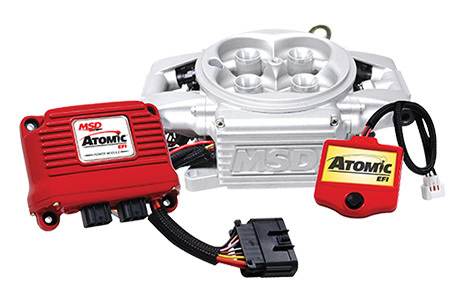Carburetor or Fuel Injection?

Most diehard carburetor aficionados have gradually switched
to EFI, but there are still plenty of modern builds using this old school fuel
technology. Fox bodies are a natural candidate for this conversion since the
5.0 used carburetors during its first few years of production. Why would you
want to use a carburetor, and when should you stick with EFI?
Why Stick with EFI?
Fuel injectors can be adjusted to deliver the right amount of fuel across the
entire RPM range, providing power regardless of engine speed. This makes
EFI-equipped cars better for driving on the street, developing low end power
without sacrificing top end.
The spraying action of the injectors mixes the fuel better than the Venturis on
the carburetor. This allows for leaner mixtures, increasing fuel economy.
If you're not familiar with carburetors, prepare for a steep learning curve: it
can take a while to learn the right mix of jet settings to get the engine to
run right. Once everything is fitted, you're stuck with that tune until you do
some more work under the hood. With EFI, you can plug in an ECU tuner to adjust
fuel delivery and timing to best fit your current setup, and can even make
multiple tunes to let you choose between street and track modes.
Why Switch to a Carburetor?
While a daily driver needs to perform under a wide range of engine speeds, a
race engine is usually going to be running at the limit all the time, removing
the need for a wide powerband. Fuel consumption also isn't an issue, reducing
the benefits of EFI.
EFI needs a lot of sensors to run. By switching to a carburetor, the EEC,
sensors and wiring can all be removed, lowering your car's weight. Since the
5.0 is basically a revised 302, there are plenty of options for non-electronic
parts where they're needed.
If you've done an engine swap, getting an EFI setup to work can be a huge
hassle. Some builds based around the Windsor block can use the existing EFI
with a few modifications, but if you're starting from the ground up, a
carburetor eliminates several tuning variables, not to mention the wiring and
sensors needed to give the new ECU a good picture of your engine's current
condition.
There are more choices when it comes to carburetor intake manifolds, letting
you pick the perfect runner length and design for your application. However,
there are also throttle body EFI systems available like Holley's Sniper that
are designed to fit these manifolds, letting you get the best of both worlds.
What do I Need to Use a Carburetor?
Making the conversion takes more work than simply bolting on the appropriate
carburetor and intake manifold.
EFI requires much more fuel pressure than a carburetor, so an appropriate low
pressure fuel pump needs to be installed. This pump needs to be paired with
larger fuel lines to maintain the flow necessary to keep the float bowls full.
With the EFI system eliminated, the ECU won't be able to adjust the spark. A
Duraspark II ignition can be adapted to fit, but you'll be better off using a
stand-alone system from a manufacturer like MSD, especially for high
performance applications. These systems are easier to tune and benefit from
modern technology for more reliable performance. Likewise, the fuel pump needs
to receive a signal to switch on when fuel is needed now that the ECU is out of
the picture. Other useful sensors like the oil pressure sender and coolant temp
sensor can be rewired with a little work.
A throttle linkage needs to be added that will fit to the carburetor. Since the
5.0 had been offered with carburetors from the factory, it's not hard to find
something that will work. On automatics, a throttle valve cable is needed to
get the transmission to shift at the right time and keep the fluid pressure
where it needs to be to keep the transmission's clutches from burning out.
Which Fuel System Should I Use?
Carburetors may sound simple, but setting one up take a lot of work and a lot
of parts. For most Mustang owners, the added drivability and tuning options of
an EFI setup makes it the better option. However, if you're going for an
extreme build that will mostly be used on the track, a carburetor may make
things easier.
How Do I Get Started?
Anderson Ford Motorsport has helped their customers build high performance
Mustangs since the dawn of the Fox Body performance boom. We have everything you need for your build, whether you want a little more performance from your
daily driver or you want a serious drag racer.
Recent Posts
-
Bringing the Fox Body Mustang into the 21st Century with Holley Terminator X
Anderson Ford Motorsport has been in the Fox Mustang performance industry since 1989. One of the bi …22nd Oct 2021 -
Roush Supercharger install on a 2019 Ford Mustang
Check out this 2019 Ford Mustang before and after we installed a Roush Supercharger. …21st Feb 2020 -
All Blower Installations are not Equal.
Why Should You Choose a Company to Install Your Blower That Has a Dyno Facility In-House?Are all de …24th Jan 2020

